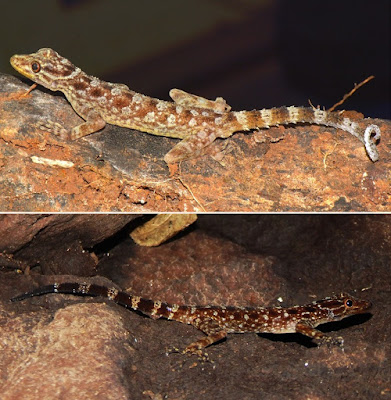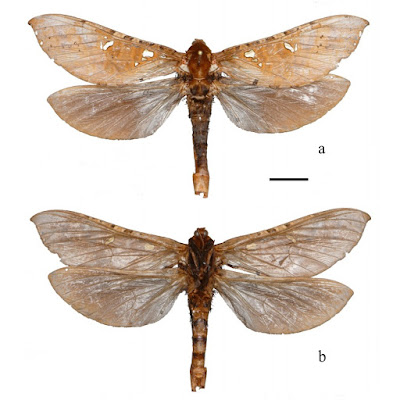[Most Recent Entries] [Calendar View]
Thursday, May 23rd, 2019
| Time | Event | ||||||
| 2:22a | [Herpetology • 2019] Cnemaspis muria • Hiding in Plain Sight on Gunung Muria: A New Species and First Record of Rock Gecko (Cnemaspis Strauch, 1887; Squamata, Gekkonidae) from Java, Indonesia
Abstract We describe a new species of rock gecko of the genus Cnemaspis from Java, Indonesia, representing the first record of the genus for this Island. The new species was collected from the southern slopes of Gunung Muria, a dormant volcano in Central Java. The new species is easily distinguished from all congeners by having a maximum SVL of 58.1 mm in males and 56.9 mm in females; a pair of sharp conical tubercle clusters on the occiput; a warty bridge on the nuchal loop, extending from the upper tympanum and curving to the nape; dorsal tubercles not linearly arranged; 18–20 paravertebral tubercles; postmentals separated by one scale; gular, pectoral and abdominal scales, ventral scales of fore- and hindlimbs, and subcaudal scales keeled; no tubercles on lower flank; precloacal and femoral pores absent; enlarged submetacarpal scales present on the first digit of the manus; 38–40 ventral scales; 31–35 lamellae under fourth toe; two postcloacal tubercles on each side; enlarged median subcaudal scales row present; caudal tubercles encircling tail; and a sexually dimorphic ventral color pattern, with males having a yellow belly and females white and the ventral surface of the tail in males yellow proximally changing to white at mid-length, whereas in females, alternating black and white rings completely encircle the tail, which is black distally. Keywords: Reptilia, Central Java, Cnemaspis, first record, Mount Muria, new species Cnemaspis muria sp.nov. Muria Rock Gecko Cicak Batu Gunung Muria Holotype. MZB. Lace. 14571 (Fig. 2A), an adult male from the river bank at Gunung Muria, Kajar (village), Dawe (District), Kudus (Regency), Jawa Tengah (Province), Indonesia (...; elevation 599 m asl), collected on 11 August 2018 by Awal Riyanto, Misbahul Munir, Rubby Alfian, Lianita Rarasandy and Rega D. Ganiarta. Diagnosis. Cnemaspis muria sp. nov. differs from its congeners in Southeast Asian by the following combination characters: (1) maximum SVL of at least 58.1 mm in males and 56.9 mm in females, (2) a pair of sharpe conical tubercle clusters on occiput, (3) nuchal loop bearing a bridge of warts from the upper tympanum to the nape and made in a curved line, (4) dorsal tubercles not linearly arranged, (5) 18–20 paravertebral tubercles, (6) postmental separated by a single scale, (7) gular, pectoral, abdominal, subantebrachial, subbrachial, subfemoral, subtibial and subcaudal scales keeled, (8) no tubercles on lower flank, (9) both precloacal and femoral pores absent, (10) enlarged submetacarpal scales present at the base of first finger, (11) enlarged submetatarsal present at the base of first toe , (12) 38–40 ventral scales, (13) 31–35 lamellae under fourth toe, (14) two postcloacal tubercles on each side, (15) enlarged median subcaudal scale row present, (16) caudal tubercles encircling tail, (17) sexually dimorphic in color pattern: males with a yellow belly and the proximal subcaudal surfaces yellow becoming white distally, female with a white belly with proximal subcaudal surface of alternating white and black rings and black coloration distally. Etymology. The specific epithet muria is a noun in apposition and refers to Gunung Muria, the type locality of this species, and so far, the only known locality for the genus Cnemaspis in Java. Distribution. Cnemaspis muria sp. nov. is only known from its type locality, in the southern foothills of Gunung Muria, a dormant volcano 1602 m in maximum elevation, located in the center of the Muria Peninsula of northern Central Java (Jawa Tengah). Gunung Muria represents the first, and so far, the only known locality for the genus Cnemaspis in Java (Fig. 7). Natural history. Cnemaspis muria sp. nov. is a scansorial species known only from large granite rock microhabitats along rivers and coffee plantations (Fig. 8) on the southern slope of Gunung Muria at middle elevations, between 560 and 599 m. The holotype was caught at night, hanging on a tree root, 2 m above a dry river bank. The paratypes MZB. Lace. 14564 and MZB. Lace. 14572 were also caught at night, whereas the other paratypes were caught during the day hanging on shaded crevices of rocks. MZB. Lace. 14572 and four another specimens not collected were found foraging on rock walls, and sympatric with Cyrtodactylus sp.
Awal Riyanto, Misbahul Munir, Andri I. S. Martamenggala, Yuli Sulistya Fitriana and Amir Hamidy. 2019. Hiding in Plain Sight on Gunung Muria: A New Species and First Record of Rock Gecko (Cnemaspis Strauch, 1887; Squamata, Gekkonidae) from Java, Indonesia. Zootaxa. 4608(1);155–173. DOI: 10.11646/zootaxa.4608.1.9 | ||||||
| 3:15a | [Entomology • 2019] Walkeriella miraculosa • A New Genus of Moth (Lepidoptera: Hepialoidea: Hepialidae) from South-East Peru
Abstract Walkeriella miraculosa gen. n. et sp. n. (Lepidoptera: Hepialoidea: Hepialidae) is based on two specimens collected from rainforest southwest of Puerto Maldonado, Tambopata, Madre de Dios department, southeastern Peru. The distinct genitalia and wing venation separate this taxon from other genera of Hepialidae although four derived characters states are shared in common with the cibyrine clade. The holotype male is deposited in the collection of the Museo de Historia Natural, Lima, Peru. Keywords: Lepidoptera, morphology, Neotropical, new genera, taxonomy Walkeriella gen. nov. Type species: Walkeriella miraculosa sp. nov., monotypic by present designation. Diagnosis. Externally distinguished from all other Pan-American Hepialidae by a large white spot edged with dark brown at the base of each discal cell and by the large curved spot between Rs1 and M1 at the outer anterior discal cell. Walkeriella gen. n. is also recognized by the distinctive male genitalia, particularly the valva with its concave inner (medial) surface extending from the base to the apex in contrast to either a blade-like shape or lobular shape in the other American species, and by the ‘oxycanine’ venation on the forewing and ‘hepialine’ venation (Dumbleton 1966) on the hindwing with partial fusion of Rs1+Rs2 and Rs3 at their base. ... Etymology. This new genus is named for Francis Walker, a British entomologist, who described some Neotropical Hepialidae species in the 19th century. The name follows the tradition of Druceiella, Dugdaleiella Grehan & C. Mielke, Hampsoniella, Kozloviella Grehan & C. Mielke, and Pfitzneriella Viette. The gender of the name is feminine. Remarks. The presence of Walkeriella gen. n. in southern Peru, a relatively well surveyed country, is surprising since no other similar taxon is so far known from the Neotropical region. The presence of a strongly developed posterior lateral knob, a broad intermediate connection between the tergosternal bar and the lateral ridge and a broken anterior margin at the tergosternal connection, along with a very close parallel position between the outer hindwing Sc and R veins support inclusion of Walkeriella gen. n. within the ‘cibyrine’ cluster of genera (Grehan 2012). The configuration of Rs1+Rs2 and Rs3 is unique among all Hepialidae genera and this is the first case that both hepialine and oxycanine venations are found in the same species. In the holotype the left forewing has an oxycanine arrangement (Rs3 joining the common stalk of Rs1+Rs2) whereas the right wing has a hepialine arrangement with Rs3 joining the base of Rs4. The hindwing arrangement is hepialine on both sides. The paratype has oxycanine venation on both forewings and hepialine venation on both hindwings. Further investigation will be necessary for a better understanding of this pattern. Walkeriella miraculosa sp. nov. Diagnosis. The single known species may be recognized using diagnostic attributes of the genus. The male genitalia show the most important diagnostic features: (i) asymmetrical projection of the pseudotegumen; (ii) valva with a ventral expansion; and (iii) phallus long and narrow, tapering to apex. Distribution. Walkeriella miraculosa sp. n. is known from the type locality, about 40 Km southwest of Puerto Maldonado, Tambopata, Madre de Dios department, Peru at 230 m. (Fig. 10). Ethology. All specimens at the type locality were attracted to light at dusk. Etymology. The species name miraculosa is a feminine Latin noun in singular nominative meaning wonderful. Carlos G. C. Mielke, John R. Grehan and Juan Grados A. 2019. Description of Walkeriella miraculosa, gen. n. et sp. n. from South-East Peru (Lepidoptera: Hepialoidea: Hepialidae). Zootaxa. 4609(2); 335–342. DOI: 10.11646/zootaxa.4609.2.8 |
| << Previous Day |
2019/05/23 [Calendar] |
Next Day >> |










